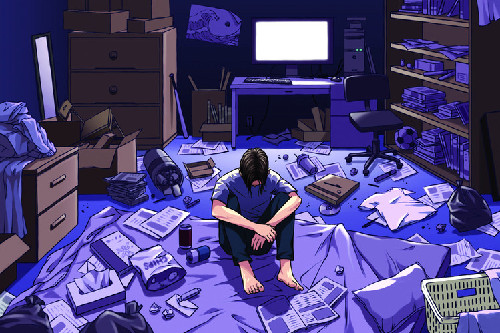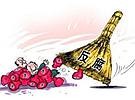
When the Kimura family moved here from Tokyo, their middle school-aged daughter missed her old friends. Midway into her first year in high school, she stopped going. Between 14 and 19, she barely left the house, and for one year hardly left her room, interacting only with her parents.
木村(Kimura)一家刚从东京搬到这里的时候,家里上初中的女儿十分想念她的老朋友。高一念了一半,她就辍学了。14至19岁期间,她基本不出家门,曾经有整整一年几乎没离开过自己的房间,而且只跟父母打交道。
Now 33 and recovered, Ms. Kimura says she was “hikikomori.” That’s the name of a type of social withdrawal that can be so severe, people with it don’t leave their houses for years. It’s also what those who suffer from the condition are called.
现年33岁的木村女士说,她曾是个“隐蔽青年”(hikikomori)。“隐蔽青年症候群”指的是一种社交退缩症,这种病症可能会达到相当严重的地步,患者终年不出家门。“隐蔽青年”则用来指代罹患此病的群体。
The puzzling condition is often thought of as a Japanese phenomenon, affecting an estimated 500,000 to two million in Japan, according to projections from academic surveys. Published reports also have described cases in the U.S., Hong Kong and Spain, among other countries.
这一令人迷惑不解的病症经常被视为一种日本社会现象。据学者调查推测,日本约有50万至200万人深受其害。而在已发表的报告中,对于美国、香港、西班牙和其他国家的相关案例也有描述。
In Japan, hikikomori has been a household word since the 1990s, with many experts calling it one of the biggest social and health problems plaguing the country. Yet the causes and treatments of the condition—or even whether it’s a mental illness or not—remain poorly understood. And while the Japanese government has poured significant funds into helping hikikomori, treatment success rates remain low.
20世纪90年代以来,“隐蔽青年”成为日本人人皆知的一个词汇。许多专家将其视为制约日本发展的一大社会与心理健康问题。然而,我们对其产生的原 因、治疗方法,甚至这是否应该被归为一种心理疾病,都知之甚少。尽管日本政府已投入大量资金帮助“隐蔽青年”,但治愈率依然很低。
The condition illustrates the difficulty of defining mental illness and raises questions about the role society plays in shaping, allowing or even creating problematic behavior. Researchers in Fukuoka have set up an international collaboration to try to answer some of these questions.
“隐蔽青年症候群”充分证明了心理疾病的界定难度,也质疑了社会在问题行为上的作用,包括社会对问题行为的影响和容忍,甚至包括问题行为是否由社会引发。福冈的研究人员已发起一项国际合作项目,试图解开这些疑问。
Solving the hikikomori riddle has taken on greater urgency in recent years. Sufferers often are men in their 20s and 30s who would be in the workforce but instead are being supported largely by their parents. Government officials worry about who will take responsibility for long-term hikikomori when their parents retire or die.
近年来,揭开“隐蔽青年症候群”谜题已变得愈加迫切。“隐蔽青年”多为20岁至30岁的男性。本该在工作的他们如今反而基本倚靠父母供养。政府官员们担心,一旦他们的父母退休或离世,将无人为“隐蔽青年”负责。
Fukuoka, a city of 1.5 million 550 miles southwest of Tokyo, about four years ago opened a support center, which the Japanese government requires of every prefecture in the country. 福冈位于东京西南方1,500,550英里。大约四年前,按照日本政府对各县市的要求,福冈开设了一家“隐蔽青年”援助中心。
Called Yokayoka, which means, “It’s OK, don’t worry about it,” in the local dialect, the one-room support center is linked to a youth employment facility. The center primarily fields phone calls from hikikomori or, more often, their worried parents. It also offers support groups for hikikomori and their parents. However, only a small number of hikikomori actually show up at the center. Of those, a minority are treated successfully, staffers say.
援助中心名叫“Yokayoka”,当地方言的意思是“没事儿,别担心”。这家援助中心只有一个单间,与一所青年就业机构相连。援助中心的主要工作 任务是接听“隐蔽青年”的电话,但来电的更多是忧心忡忡的父母。他们也为“隐蔽青年”及其父母成立了互助小组。但工作人员称,仅有少数“隐蔽青年”会来, 而他们中只有一小部分被成功治愈。
Takahiro Kato, a professor in the neuropsychiatry department at Kyushu University in Fukuoka, is working with the support center to study hikikomori in a more rigorous and systematic way. Dr. Kato and a team of Japanese and international collaborators that includes Alan Teo, a psychiatry professor at Oregon Health & Science University, want to better define what hikikomori is. They also hope to understand the social and biological underpinnings of the condition to improve treatments.
加藤贵裕(Takahiro Kato)是福冈九州大学神经精神学科的一名教授。他正与援助中心合作,用更严谨系统的方法对“隐蔽青年症候群”进行研究。加藤博士及其所属的一支包括日 本和国际专家在内的合作团队,正试图为“隐蔽青年症候群”下一个更为明确的定义。俄勒冈健康与科学大学神经病学教授张艾伦(Alan Teo)也是团队成员之一。该合作团队还希望了解这种病症的社会和生理因素,并改善治疗方法。
People who consider themselves hikikomori exhibit a wide range of symptoms, including depressive, autistic and obsessive-compulsive tendencies. A minority appear addicted to the Internet, says Dr. Kato, a 40-year-old psychiatrist.
现年40岁的精神病学家加藤博士称,那些自认“隐蔽青年”的群体表现出的症状各有不同,包括抑郁症、自闭症和强迫倾向,少数人上网成瘾。
Yossy, 31, came for a recent hikikomori support group. He says he didn’t leave his parents’ house for six months after harassment from his boss at his speech therapy internship led him to quit. After that, he did begin to visit friends occasionally and volunteer at a library. But after four years, he still hasn’t held a full-time job.
31岁的Yossy近期曾到援助中心来参加过互动小组。他表示,自己曾是一名语言障碍矫正实习医师,因老板骚扰而辞职,之后他有半年一直待在父母家。从那以后,他偶尔也去会见朋友,或者在图书馆做义工。但四年过去了,他仍然没有一份全职工作。
Hikikomori appears to be a condition distinct from other mental illnesses, Japanese experts say. Only about half of those with the condition would be diagnosed with a disorder in the U.S. psychiatric diagnostic manual commonly known as DSM-5, according to one survey of 4,134 Japanese residents published in Psychiatry Research in 2010. But large-scale survey data on hikikomori remains limited.
日本专家们认为,“隐蔽青年症候群”似乎有别于其他精神疾病。一项针对4134名日本居民的调查显示,仅有约一半的“隐蔽青年”符合美国精神病学会 《精神障碍诊断与统计手册》(Diagnostic and Statistical Manual of Mental Disorders,俗称DSM-5)的诊断标准,会被诊断为精神障碍。调查结果发布在2010年的《神经病学研究》杂志上。但针对“隐蔽青年症候群”的 大规模调查数据仍然很有限。
Japanese experts point to strict parenting practices and pressure that children feel to succeed as contributing factors. Yet hikikomori often live with their parents, and these parents can be soft in forcing their children to go to school or leave the home. They often bring trays of food to their bedroom doors.
日本专家指出,严厉的家庭教育和成功压力是“隐蔽青年症候群”的诱因。“隐蔽青年”经常与父母同住,而他们的父母在敦促孩子上学或离家方面却表现得心慈手软。他们常把食物端到孩子的房门口。
Current thinking is that providing hikikomori with positive social interactions will help them reintegrate with the outside world. Michiko Asami, president of the nonprofit that runs Yokayoka, welcomes each hikikomori with a big smile and tries to initiate a nonjudgmental conversation. Sometimes they sit silently for multiple sessions or won’t look at her. Gradually, some do.
目前来看,为“隐蔽青年”提供积极的社会互动将有助于恢复他们与外界的联系。负责Yokayoka援助中心运作的非营利性机构主席浅海美智子 (Michiko Asami)笑容满面地欢迎每一位“隐蔽青年”的到来,她试图发起一次无偏见的对话。有时,“隐蔽青年们”会在小组交谈时静静地坐着,亦或根本不看她。渐 渐的,一些人开始参与进来。
Vocabulary
hikikomori: 隐蔽青年,蛰居族
social withdrawal: 社交退缩症
projection: 推测
plague: 折磨
neuropsychiatry: 神经精神病学
psychiatry: 精神病学
underpinning: 基础
autistic: 孤独症的
obsessive-compulsive: 强迫性神经(官能)症的
nonjudgmental: 无偏见的




